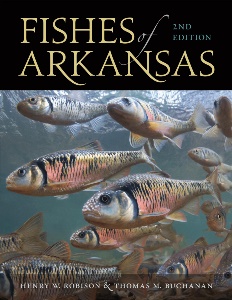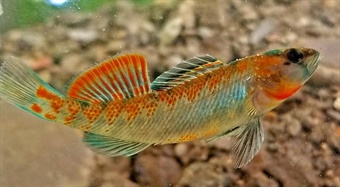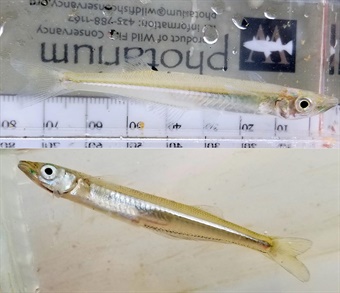 Last year saw the release of the long-anticipated Second Edition of “Fishes of Arkansas” by Henry Robison and Thomas Buchanan. At a hefty 959 pages, the new edition is a substantial expansion on the first edition, published in 1988. The authoritative reference for anyone interested in Arkansas’s incredible icththyofauna (fish life), this book includes some 243 species. It features updated dichotomous keys (keys used for identification), beautiful photographs, and detailed species accounts, with comprehensive information on the identification, taxonomy (classification), natural history, and conservation of every fish species. The update includes improved range-maps, sections on the history of ichthyology (study of fish) in Arkansas, the biogeography of our aquatic habitats, a lengthy glossary, and a 109-page literature cited section that compiles scientific publications spanning the history of ichthyology in Arkansas.
Last year saw the release of the long-anticipated Second Edition of “Fishes of Arkansas” by Henry Robison and Thomas Buchanan. At a hefty 959 pages, the new edition is a substantial expansion on the first edition, published in 1988. The authoritative reference for anyone interested in Arkansas’s incredible icththyofauna (fish life), this book includes some 243 species. It features updated dichotomous keys (keys used for identification), beautiful photographs, and detailed species accounts, with comprehensive information on the identification, taxonomy (classification), natural history, and conservation of every fish species. The update includes improved range-maps, sections on the history of ichthyology (study of fish) in Arkansas, the biogeography of our aquatic habitats, a lengthy glossary, and a 109-page literature cited section that compiles scientific publications spanning the history of ichthyology in Arkansas.Thirty-two years is a long time when it comes to our ever-increasing knowledge of taxonomy, systematics, and species distributions. During that time, many species have been reclassified, given new scientific names, or split into multiple species. New species have been described in Arkansas and other previously known species from surrounding states have been discovered here. Our knowledge of many species distributions has greatly increased in many cases. In other cases, species ranges have actually expanded or contracted in that time.
 The book includes nine newly described or provisionally described species, including several that do not yet have formal scientific names. One example is the “Ozark Darter” (Etheostoma sp. cf. spectabile), a beautiful fish endemic to the White River of northern Arkansas and southern Missouri. This is one of seven species in Arkansas, some now formally described and some not, that have been at one time or another considered regional forms or subspecies of the Orangethroat Darter (Etheostoma spectabile). Over the last couple of years, biologists from the Arkansas Game and Fish Commission (AGFC) and Arkansas Natural Heritage Commission (ANHC) have collaborated on field expeditions to document Ozark Darter populations and their regional variation in watersheds across northern Arkansas.
The book includes nine newly described or provisionally described species, including several that do not yet have formal scientific names. One example is the “Ozark Darter” (Etheostoma sp. cf. spectabile), a beautiful fish endemic to the White River of northern Arkansas and southern Missouri. This is one of seven species in Arkansas, some now formally described and some not, that have been at one time or another considered regional forms or subspecies of the Orangethroat Darter (Etheostoma spectabile). Over the last couple of years, biologists from the Arkansas Game and Fish Commission (AGFC) and Arkansas Natural Heritage Commission (ANHC) have collaborated on field expeditions to document Ozark Darter populations and their regional variation in watersheds across northern Arkansas. The book documents several species that have been “split,” i.e. what was once thought to be a single species has been found to consist of more than one species based on new information, which can include new data based on morphology (structure and form), genetics, or natural history. One of many examples in the new book is the case of the Brook Silverside (Labidesthes sicculus) and Hardy Silverside (L. vanhyningi). What was once thought to be a single species distributed throughout most of Arkansas actually consists of two species that differ subtly in body proportions, morphological features, and coloration. The Hardy Silverside is more of a lowland species found in the West Gulf Coastal Plain and Mississippi Alluvial Valley (Delta) ecoregions, while the Brook Silverside is found in highland streams in the Ozark and Ouachita Mountains, as well as the Arkansas River Valley.
The book documents several species that have been “split,” i.e. what was once thought to be a single species has been found to consist of more than one species based on new information, which can include new data based on morphology (structure and form), genetics, or natural history. One of many examples in the new book is the case of the Brook Silverside (Labidesthes sicculus) and Hardy Silverside (L. vanhyningi). What was once thought to be a single species distributed throughout most of Arkansas actually consists of two species that differ subtly in body proportions, morphological features, and coloration. The Hardy Silverside is more of a lowland species found in the West Gulf Coastal Plain and Mississippi Alluvial Valley (Delta) ecoregions, while the Brook Silverside is found in highland streams in the Ozark and Ouachita Mountains, as well as the Arkansas River Valley. Anyone with any level of interest in Arkansas fishes will get something from this invaluable resource – professional biologists, amateur naturalists, anglers, students, or those who simply wish to maintain a complete library documenting the natural history of The Natural State. The book is available through the University of Arkansas Press.
Photos:
Image 1: Cover of Second Edition of "Fishes of Arkansas" published by Henry Robison and Thomas Buchanan, image courtesy of the University of Arkansas Press.
Photo 1: Ozark Darter (Etheosotma sp. cf. spectabile), a beautiful fish endemic to the White River of northern Arkansas and southern Missouri. Photo by Dustin Lynch.
Photo 2: Brook Silverside (Labidesthes sicculus), above, and Hardy Silverside (L. vanhyningi), below. These fish were once thought to be a single species, but actually consists of two species that differ subtly. Photo by Dustin Lynch.

